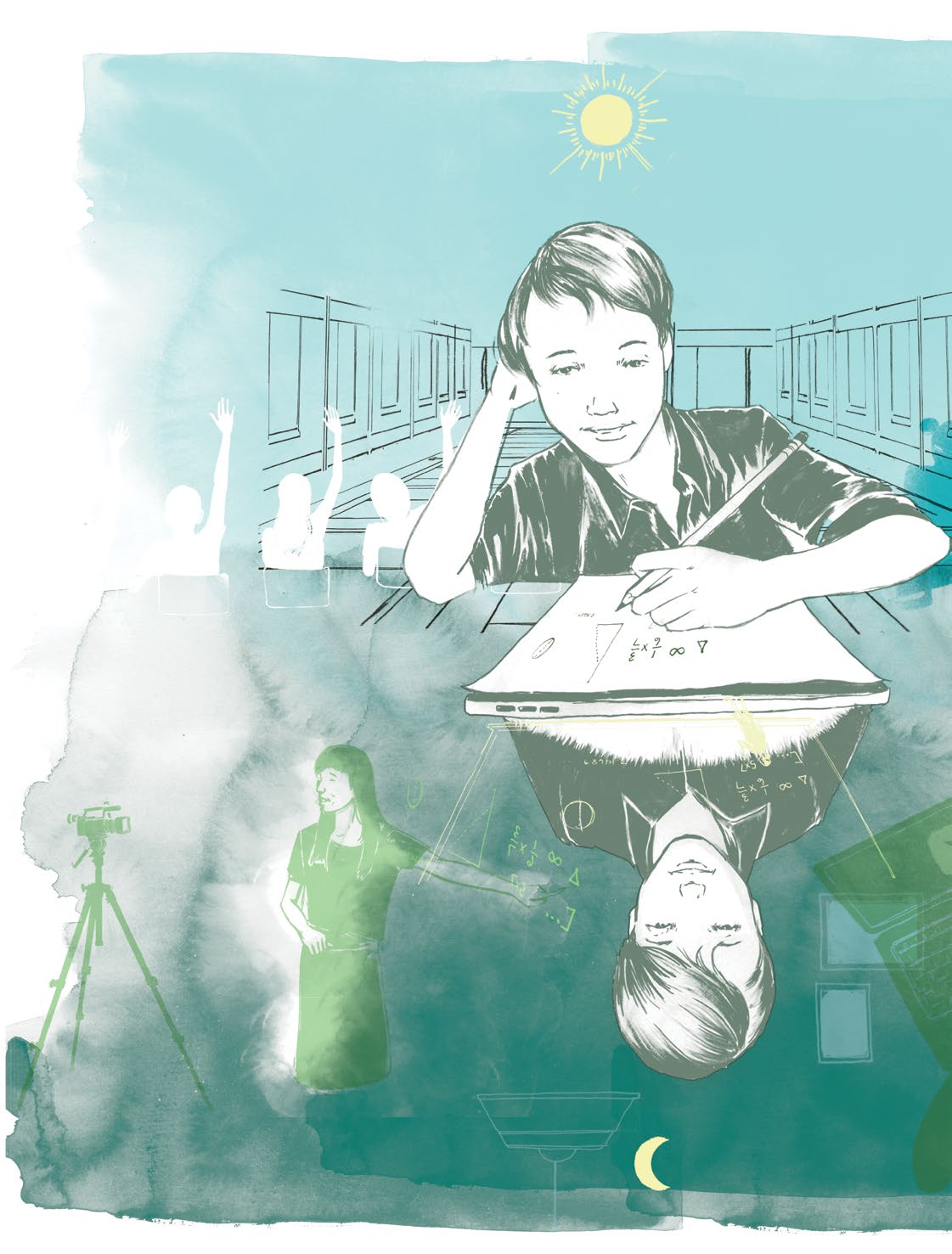Share this page
By John Hoffman
Illustrations: Aaron McConomy/Colagene

Students are working individually, in pairs or in small groups in Dianne Fitzpatrick’s accounting class. Two girls are collaborating on questions from a textbook. At another desk, a girl and boy are doing calculations on their tablets. “Show me your device so I can see what you’re doing wrong,” the girl says to her partner. Some are watching instructional videos Fitzpatrick, OCT, has shared on YouTube.
There is a test tomorrow, so Fitzpatrick has posted questions on Angel, her learning management program (that administers and tracks e-learning) and students are working through them. “If you can do those,” she says, “you’ll be in good shape for the test.” She circulates, answering questions and in some cases keeping students on task.
The one thing you won’t often see here is Fitzpatrick at the blackboard delivering a lesson — this is a flipped classroom. That means students do their homework in class and watch the videos their teacher has posted online, at home. They make notes as they watch and write down questions to ask during their next lesson. Time with Fitzpatrick is spent working on their own or doing group learning activities designed to encourage students to apply what they’ve learned from the videos. Short moments of group instruction occur when a question raises a point that the whole class will benefit from hearing.
This new approach is rare in Ontario, however, a small but growing number of OCTs are getting into it. Its proponents are enthusiastic (and vocal!), saying that “flipping” has a number of advantages. It makes students more responsible for their learning, it allows teachers to be available to help when students are working through problems and it’s a way to further engage them in the tech culture they’re already immersed in.
Fitzpatrick teaches business at Brampton’s Central Peel SS, part of the Peel DSB, which launched a pilot flipped classroom program in 2012 that included PD days, on-site visits and an information day that 200 teachers attended.
In 2012, Fitzpatrick took part in a professional development trip to Clintondale HS, near Detroit, Mich., where principal Greg Green flipped all of his 2010 freshman classes in his underperforming school. This was an attempt to address absenteeism, high failure rates and low test scores. It worked so well — a 33 per cent reduced failure rate in English and a 31 per cent reduction in math failures — that he flipped his entire school the next year.
Fitzpatrick was so impressed that she decided to flip two of her accounting classes. She thought using technology would appeal to her students and liked the idea of being available to help them when they’d need it the most.
Spend a few moments in Fitzpatrick’s class and you’ll quickly see this in action. A girl raises her hand. “This question doesn’t make sense,” she says. The teacher leans down and reads. Then she offers a different perspective and points the student in the right direction. Now that the girl is clear on what to do, she gets to work. “At home I wouldn’t have been able to do that question,” the student says.
Flipped classroom pioneer Aaron Sams says the primary goal for this approach is to make students active and responsible learners, rather than passive vessels that he must fill with knowledge.
That’s what drove Nour Harriz, OCT, a science and math teacher at Ottawa’s Lisgar CI, to start flipping his classes three years ago. “I was concerned that students had become completely dependent for their learning,” he says. “That meant no accountability at their end. I wanted my students to become their own resources.”
Harriz’s move toward a more interactive presence has led to an increase in the amount of work his students complete. “Students who don’t do their homework often get stuck because they lack the background knowledge that enables them to decode a question,” Harriz says. “If only 40 to 60 per cent of the lesson is retained, the student is not going to be able to do the homework without help.”
Fitzpatrick says the flipped model allows her to zero in on which students are struggling. “In the past, we’d do a unit, have the test and three kids would fail — usually the ones who hadn’t asked for assistance,” she says. “So by the time I found out they were behind, it was time to move on to the next unit. Now I find out who is struggling well before the test, when I still have time to help them.”
Many parents are also finding the value in the flipped classroom format. Annouk Utzschneider, whose son is in Grade 7 at École Le Mascaret, in Moncton, NB, says the videos that his teacher posts are instructive not only for her, as a homework guide, but also for the math tutor she hired last fall. “Because of the videos the tutor knows exactly what my son is learning and how it was explained,” says Utzschneider. She has noted a huge improvement in his marks this year. “I’m sure the tutoring has helped, but I don’t think it would be as effective without this method and the videos.”
Agnès Demangeon, OCT, is using the flipped classroom with about two-thirds of her adult education classes at l’École des adultes Le Carrefour in Ottawa. “Initially students were surprised that they’d be watching videos,” she says. “But as soon as they saw the first one and discussed it, their reactions were positive.” Flipping is still new to Demangeon, so she’s not ready to declare the experiment a success, but so far she’s encouraged. “The first group had excellent results on their final exam,” says Demangeon. “This approach promotes useful discussions and reflection, which allows students to deepen their understanding of the material.”
Katarina Hlavnicka, OCT, the head of mathematics at Brampton’s North Park SS, started flipping her Grade 9 applied math course last September. But she made an important modification — her students almost always watch their videos in class. “It’s unrealistic to ask them to watch a video at home, take notes and come back to class with questions,” she says. “It might work in Grade 12 advanced, but not Grade 9 applied.”
Hlavnicka is convinced that this increased use of technology helps to engage her students. “Today’s youth enjoy tech devices,” she says. “Incorporating them into school increases their motivation and makes mathematics more relevant to their lives.” She says using technology also helps free up time during each class. Her students are now in their seats and logged-in within four minutes.
Michel Larocque, OCT, flipped his Grade 12 chemistry class in January and combines at-home podcasts with in-class mini-lectures. “I still do a lecture each day, but it’s a quick one (10 or 15 minutes) because the details related to the subject matter have already been discussed in the podcast,” says the science teacher at Windsor’s École secondaire catholique E. J. Lajeunesse. “I’m sure it will take some time to find the ideal process, but I’m convinced this approach works,” says Larocque.
When Fitzpatrick first explained how flipping works, her accounting students were excited. But eight weeks into the program, students started to resist. “They began to see that this would actually be more work for them,” Fitzpatrick says. Individuals who may have become distracted in a traditional classroom found they needed to pay closer attention in the flipped model.
Students’ responses are mixed but mostly positive, Fitzpatrick says. When she surveyed them, their biggest complaint was that the videos were too long. “I’m working on keeping them shorter,” she says. Some suggested adding a quick quiz at the end of each, which is now in place for her Grade 12s. One commented that he prefers the traditional style. “I’m more of an auditory learner than a visual one,” he said. (Ironically, this same student received the highest mark in the history of the course last year.)
Sounds pretty good but what if students don’t (or can’t) view the videos at home? “They watch them in class,” says Fitzpatrick. “I realized that it only takes a few minutes, it’s not disruptive and I’m right there to make sure they do it.”
Fitzpatrick uses the Remind 101 app (remind101.com) to notify students (by text or email) to watch the videos. If they miss three videos in a row, Fitzpatrick calls their parents and signs them up as well.
While flipped classroom activity seems to be more common at the secondary level, Rick McCleary, OCT, at Burford District ES near Brantford, says his Grade 6 classroom is not and may never be fully flipped. “I think it is good for certain subjects, but I don’t think a 100 per cent flipped environment is appropriate in an elementary homeroom,” he says. “It would be wrong to assign multiple videos per day as homework.”
When McCleary started, he took it one lesson at a time. Now he chooses two to five lessons per week that will work well in video and provide him with the most useful face-to-face time with his students. “I started with math and some science, and then I quickly realized how well flipping would work with art and physical education,” McCleary says.
Several elementary schools in the Peel DSB, including Williams Parkway Senior PS, are also taking steps toward flipping. “We have four teachers taking lead roles,” principal Ozma Masood, OCT, explains. “They are trying out various aspects, noticing the problems and looking for solutions.”
Some teachers, for example, found the prospect of creating videos daunting, so they tried searching online, but that turned out to take almost as long as making their own. While most are making their own videos, they aren’t teaching the entire course that way. Williams Parkway’s physical education teacher John Uren, OCT, made a video about the muscle groups in the human body. Students watched them at home then did in-class exercises that worked each group. “This approach meant less time with me talking and more time for doing the activity,” Uren says.
Whether the flipped classroom will have legs in Ontario is anyone’s guess, but this new method may prove less radical than it sounds. The future of flipping doesn’t have to be an all-or-nothing approach to how teachers structure their lessons but rather another tool they can use to engage students through the kinds of technology they’re already using.

Is it really pedagogy when videos are the principal means of instruction? For Katarina Hlavnicka, OCT, the answer is a resounding yes. “For many, many years teachers used textbooks as resources and no one was questioning whether or not teachers would be redundant,” she says. “We’re just using different types of resources these days, and some of them happen to be in the form of a video.” Hlavnicka feels that the increased one-on-one time with her students allows for the most effective form of teaching, especially with struggling students. “Since I flipped my classrooms, I have become a much more effective teacher.”
Dianne Fitzpatrick, OCT, creates her videos with Camtasia (bit.ly/1iiVNAp), a screen capture software (also known as screencasting) that allows voiceovers. She then posts them — along with her assignments, mock tests, and various instructions and sample test questions — on a password protected website that she creates with Angel, a learning management software now owned by Blackboard (blackboard.com). It’s similar to an online course; students can log on from anywhere.
Most of her videos are about five to 10 minutes long. But, can a video of this length cover the content discussed during a regular class? Absolutely! “There’s a lot of wasted time in class — for example, interruptions, dealing with distractions and unrelated questions,” she explains. “I can cover the content for a whole period in 10 minutes of video.”
If you’re thinking of flipping your classroom, consult these handy resources for advice on where to start and step-by-step support on how to properly implement this model into your teaching.